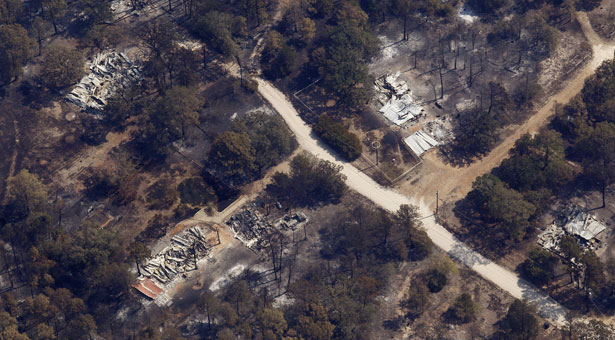You are here
by Rick Jervis - USA Today - September 7, 2011

A residential street is lined with homes destroyed by a wildfire in Bastrop.
BASTROP, Texas – Todd Jamison, a division chief for the Little Elm Fire Department near Dallas, has fought house fires and wildfires.
But when wildfires — such as the ones in this area 25 miles east of Austin — engulf homes and neighborhoods, his job becomes far more complex, he says.
On Wednesday, Jamison, one of hundreds of Texas firefighters helping fight a nasty blaze here, revisited one of the homes he and his team spent nearly two hours trying to save the day before. Now, it was a pile of smoldering cinderblocks. The only signs of what was once a home: a few charred lawn chairs and a melted toilet.
-
PHOTOS: Texas Wildfires
"This is a different beast for us," Jamison says of the ongoing firefight. "We're fighting to protect homes."
Texas continues to fight through the most destructive wildfire season in state history. More than 3.6 million acres have burned across the state, surpassing the previous record of 2 million set in 2006, according to the Texas Forest Service. The fires also have destroyed more than 1,800 homes — more than four times the previous record of 436 set in 2009.
Unlike most wildfires that burn in vast open prairies, the recent fires have crept destructively close to populated areas.
One of the biggest blazes ignited Sunday in the wooded neighborhoods around Bastrop. Firefighters on Wednesday were gaining control of the 33,000-acre fire that has killed at least four people, torched 45 square miles and consumed nearly 800 homes, according to the Texas Forest Service. Crews had contained about 30% of the fire.
A record-breaking drought across Texas is aiding the wildfires and pushing them closer to urban centers, state climatologist John Nielsen-Gammon says. The dry weather is killing more trees than usual, providing fuel for fires near cities, he says. As the winds pick up during winter, more fires are expected. No rain is in sight.
"We may be in a very dangerous situation for fire in urban and suburban areas," Nielsen-Gammon says.
Fighting fast-moving fires in populated surroundings is one of the most dangerous challenges crews face, says Justice Jones, a Texas Forest Service spokesman. Telephone poles snap and fall across roads, propane tanks explode in yards and residents must be evacuated as fires rage near homes, he says. Firefighters constantly must choose between fighting the fire and saving homes and lives.
A relatively small fire can do much more damage in populated areas than on open range. A 150-acre fire, not considered very big by rural wildfire standards, destroyed 35 homes near Austin on Monday, Jones says. "It doesn't take a big fire to be extremely dangerous," he says. "It's a much more complex and dangerous situation than firefighters would face in the wildlife community."
On Wednesday, residents gathered at the Bastrop convention center to look at fire maps and determine whether their homes were spared.
Jim Stovall, 42, evacuated from his Bastrop home Sunday and drove to a nearby gas station to watch the blaze spread through his community. The horizon glowed orange from the flames, and propane tanks exploded one after the other, sounding like faraway mortar rounds, he says.
"It looked like a war zone," Stovall says.
When the Bastrop fire roared to life Sunday, state fire officials enacted the Texas Intrastate Fire Mutual Aid System, a statewide resource-sharing network created earlier this year. That brought Jamison to Bastrop from Little Elm, just north of Dallas.
On Tuesday, Jamison and a crew of nine others traveled through the Pine Tree Loop neighborhood near Bastrop, trying to save homes. At one home, Jamison and his crew raked away pine needles and used a chainsaw to cut away nearby branches, trying to keep the fire at bay.
When the fire jumped into the pine trees and began to spread through the treetops overhead — a phenomenon known as "crowning" — Jamison ordered his crew out.
"It got too dangerous," he says. The fire destroyed the house.
If it were a house fire in Little Elm, Jamison would have called in five engine trucks and a ladder truck, plugged his truck into a hydrant and charged inside to fight the fire, he says. With so many pine trees around and the Bastrop fire surging in all directions, however, he had no choice but to let homes already on fire keep burning, he says.
At another house down the road, the crew brought in a bulldozer and dug a shallow moat around the property. It worked: The house was saved.
Not all homes can be saved, says Tom Nations, a battalion chief with the Denton, Texas, Fire Department who was leading teams around Bastrop on Wednesday.
"There are so many structures, and the resources we have are so limited," Nations says. "Sometimes you have to make the difficult decision of letting structures burn."
Photos - Texas Wildfires



Recent Comments